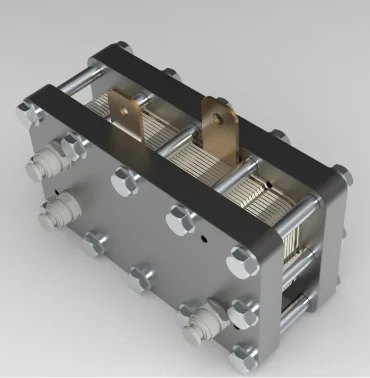Unlocking the potential of a sustainable hydrogen infrastructure is crucial in our quest for clean and renewable energy sources. And at the heart of this monumental task lies the proton exchange membrane (PEM) electrolyzer, a game-changing technology that holds immense promise. In this blog post, we will delve into the world of PEM electrolyzers and explore their benefits in paving the way towards a greener future. Join us as we unravel the role of PEM electrolyzers in enabling a sustainable hydrogen infrastructure, and discover how Gatechn New Energy Technology (Shanghai) Co.,Ltd is leading the charge in this transformative field. So buckle up and get ready to embark on an electrifying journey into the realm of innovative energy solutions!
What is a proton exchange membrane (PEM) electrolyzer?
A proton exchange membrane (PEM) electrolyzer is a cutting-edge device that utilizes electrical energy to split water molecules into hydrogen and oxygen gases through an electrochemical process. This remarkable technology employs a thin, solid polymer electrolyte membrane, typically made of a specialized material like Nafion®, which acts as the catalyst for the reaction.
The PEM electrolyzer operates at relatively low temperatures and pressures compared to other types of electrolyzers, making it highly efficient and versatile. It offers rapid response times, allowing for quick adjustments in hydrogen production based on demand fluctuations. Additionally, its compact size and modular design make it suitable for various applications, from small-scale residential systems to large-scale industrial installations.
One significant advantage of PEM electrolyzers is their ability to produce high-purity hydrogen gas without any impurities or contaminants. This purity is crucial when utilizing hydrogen in fuel cell technologies that require clean inputs for optimal performance.
Furthermore, PEM electrolyzers boast excellent efficiency levels due to their ability to operate within a wide range of current densities. They can adapt seamlessly to varying power sources such as renewable energy generation (solar or wind), grid electricity, or even excess electricity from existing processes.
Proton exchange membrane (PEM) electrolyzers are revolutionizing our approach towards sustainable energy solutions by offering high efficiency, flexibility in operation, compactness in design, and most importantly - producing pure hydrogen gas with minimal environmental impact. Now that we have explored what makes these devices so remarkable let's delve deeper into the myriad benefits they bring forth!

The benefits of using Proton Exchange Membrane (PEM) Electrolyzer
Proton Exchange Membrane (PEM) Electrolyzers offer numerous benefits that make them an attractive option for generating hydrogen gas. PEM electrolyzers have a high efficiency rate, converting electrical energy into hydrogen with minimal losses. This means less wasted energy and more cost-effective production of hydrogen.
Additionally, PEM electrolyzers are compact and lightweight compared to other types of electrolyzers. This makes them ideal for various applications where space is limited or mobility is required. Whether it's powering fuel cells in vehicles or providing backup power in remote locations, the portability of PEM electrolyzers makes them versatile and adaptable.
Another advantage of PEM electrolyzers is their fast response time. They can quickly ramp up or down their hydrogen production based on demand, making them suitable for fluctuating power requirements. This responsiveness allows for better integration with renewable energy sources such as wind or solar power, which can have variable output.
Furthermore, PEM electrolyzers operate at relatively low temperatures and pressures compared to other technologies. This not only reduces the risk of equipment failure but also simplifies system design and lowers maintenance costs.
PEM electrolyzer systems can be easily scaled up or down depending on the application and desired hydrogen production capacity. Whether it's a small-scale installation for residential use or a large industrial plant supplying hydrogen to multiple consumers, the flexibility offered by PEM technology enables customization according to specific needs.
In conclusion,
the benefits provided by Proton Exchange Membrane (PEM) Electrolyzer systems make them an attractive choice for enabling a sustainable hydrogen infrastructure. With their high efficiency, compactness, rapid response time, lower operating conditions, and scalability options they contribute towards achieving a greener future powered by clean energy solutions like Gatechn New Energy Technology (Shanghai) Co.,Ltd.'s advanced PEM electrolysers.
The role of PEM electrolyzers in enabling a sustainable hydrogen infrastructure
The role of Proton Exchange Membrane (PEM) electrolyzers in enabling a sustainable hydrogen infrastructure cannot be overstated. These innovative devices play a crucial role in the production of clean and renewable hydrogen gas through the process of water electrolysis.
One key advantage of PEM electrolyzers is their ability to operate at high efficiency levels, making them ideal for large-scale hydrogen production. This is particularly important as we strive to transition away from fossil fuels and reduce greenhouse gas emissions.
Additionally, PEM electrolyzers offer fast response times, allowing for greater flexibility in responding to fluctuations in energy supply and demand. This makes them well-suited for integration with renewable energy sources such as solar and wind power, which are inherently intermittent.
Furthermore, PEM electrolyzers have a compact design and can be easily scaled up or down depending on specific needs. Their modular nature enables decentralized deployment, promoting resilience and reducing transmission losses associated with centralized hydrogen production facilities.
By utilizing Proton Exchange Membrane (PEM) electrolyzers, we can pave the way towards a sustainable hydrogen infrastructure that supports various applications such as fuel cell vehicles, industrial processes, heating systems, and energy storage.

Conclusion
Proton exchange membrane (PEM) electrolyzers play a crucial role in enabling a sustainable hydrogen infrastructure. These innovative devices offer numerous benefits, including high efficiency, flexibility, and scalability. With the increasing demand for clean energy solutions and the need to reduce carbon emissions, PEM electrolyzers provide an efficient and environmentally-friendly method of producing hydrogen.
As we continue to explore alternative energy sources that can replace fossil fuels, it becomes clear that hydrogen holds great potential. From powering vehicles to providing backup power systems for renewable energy grids, hydrogen offers versatility and zero-emission capabilities.
With advancements in technology and increased investment in research and development, we can expect even greater efficiencies from PEM electrolyzers in the future. As more industries recognize the value of utilizing clean energy solutions like hydrogen, there will be an increased demand for reliable methods of production like PEM electrolysis.








